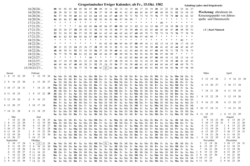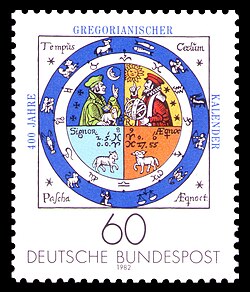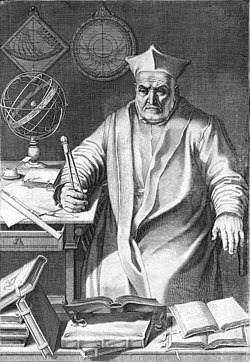Gregoriancalendarleap solstice
Autor/Urheber:
BasZoetekouw; spelling corrections and revision of subtitle by User:Gerry Ashton on 14 September 2008.
Attribution:
Das Bild ist mit 'Attribution Required' markiert, aber es wurden keine Informationen über die Attribution bereitgestellt. Vermutlich wurde bei Verwendung des MediaWiki-Templates für die CC-BY Lizenzen der Parameter für die Attribution weggelassen. Autoren und Urheber finden für die korrekte Verwendung der Templates hier ein Beispiel.
Shortlink:
Quelle:
Größe:
800 x 420 Pixel (89450 Bytes)
Beschreibung:
The date of the northern summer solstice between 1750 and 2250. The graph shows the date (in GMT) of the northern summer solstice (the moment the sun reaches it northernmost position in the sky, or the beginning of summer in the northern hemisphere) through the years. As the summer solstice occurs on the same astronomical date each year (although changes may occur on much larger time scales), the graph basically shows the difference between real, astronomical time and the Gregorian calendar. Each year, the Gregorian calendar is approximately 0.24 days faster than the astronomical calendar, which is corrected by a leap day once every four years. This 4-year cycle is clearly visible in the graph. To compensate for the largest part of the remainder of the difference, there is no leap year in 1800, 1900, 2100, 2200, as can be clearly seen in the graph, too. Note that the summer solstice in 1800 and in 2200 are not on equal dates; this shows that the leap year compensation as described before is not perfect and more complicated schemes are necessary to keep the Gregorian calendar synchronized over even longer time scales. However, the Gregorian calendar was actually intended to synchronize with the vernal equinox, not the summer solstice, which is not exactly the same thing over the medium term...
Lizenz:
Credit:
Eigenes Werk; The data was generated by Astrolabe (https://sourceforge.net/projects/astrolabegenera), which uses the algorithms described in Jean Meeus's "Astronomical Algorithms" (ISBN 978-0943396613). The data have an error of less than 2.6 minutes.
Relevante Bilder
Relevante Artikel
Gregorianischer KalenderDer gregorianische Kalender, auch bürgerlicher Kalender, ist der weltweit meistgebrauchte Kalender. Er entstand gegen Ende des 16. Jahrhunderts durch eine Reform des julianischen Kalenders. Benannt ist er nach Papst Gregor XIII., der ihn 1582 mit der päpstlichen Bulle Inter gravissimas verordnete. Er löste im Laufe der Zeit sowohl den julianischen als auch zahlreiche andere Kalender ab und bildet die Basis der Datumsdarstellung nach ISO 8601. .. weiterlesen






